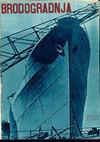基于流固耦合的船用螺旋桨水动力性能优化
IF 4.2
4区 工程技术
Q1 ENGINEERING, MARINE
引用次数: 1
摘要
与金属相比,纤维增强复合材料具有高强度、高刚度、重量轻、优越的阻尼性能和出色的设计能力等优点。通过使用合适的材料和排列铺层顺序,可以调整复合材料层合板在不同方向上的刚度特性,以满足应用的要求。因此,本研究的目的是从水动力和结构性能两方面探讨铺层型式对螺旋桨性能的影响。提出了一种基于有限元法(FEM)和计算流体力学(CFD)相结合的瞬态流固耦合(FSI)算法,并将其应用于复合材料螺旋桨的分析。将螺旋桨的水动力性能与金属材料进行了比较。比较了三种不同工况下不同铺层方案的螺旋桨推进效率、结构变形、等效应力和损伤性能。此外,还提出了一种参数优化方法,以获得具有最佳水动力性能和结构性能的复合材料叶片最合适的铺层方案。本文章由计算机程序翻译,如有差异,请以英文原文为准。
Hydrodynamic performance optimization of marine propellers based on fluid-structure coupling
Fiber-reinforced composites offer the benefits of high strength, high stiffness, lightweight, superior damping performance, and great design capability when compared to metal. The rigidity characteristics of the composite laminate in different directions may be adjusted to meet the requirements of the application by using appropriate materials and arranging the lay-up sequence. As a result, the purpose of this work is to explore the influence of lay-up type on propeller performance in terms of both hydrodynamic and structural performance. A transient fluid-structure interaction (FSI) algorithm based on the finite element method (FEM) combined with the computational fluid dynamics (CFD) technique is developed and used for the analysis of composite propellers. The hydrodynamic performance of the propeller is compared to that of a metallic material. Propeller propulsion efficiency, structural deformation, equivalent stress, and damage performance of different lay-up options under three different operating situations are compared. In addition, it is presented a parametric optimization approach to get the most appropriate lay-up program for composite blades with the best hydrodynamic properties and structural performance.
求助全文
通过发布文献求助,成功后即可免费获取论文全文。
去求助
来源期刊

Brodogradnja
ENGINEERING, MARINE-
CiteScore
4.30
自引率
38.90%
发文量
33
审稿时长
>12 weeks
期刊介绍:
The journal is devoted to multidisciplinary researches in the fields of theoretical and experimental naval architecture and oceanology as well as to challenging problems in shipbuilding as well shipping, offshore and related shipbuilding industries worldwide. The aim of the journal is to integrate technical interests in shipbuilding, ocean engineering, sea and ocean shipping, inland navigation and intermodal transportation as well as environmental issues, overall safety, objects for wind, marine and hydrokinetic renewable energy production and sustainable transportation development at seas, oceans and inland waterways in relations to shipbuilding and naval architecture. The journal focuses on hydrodynamics, structures, reliability, materials, construction, design, optimization, production engineering, building and organization of building, project management, repair and maintenance planning, information systems in shipyards, quality assurance as well as outfitting, powering, autonomous marine vehicles, power plants and equipment onboard. Brodogradnja publishes original scientific papers, review papers, preliminary communications and important professional papers relevant in engineering and technology.
 求助内容:
求助内容: 应助结果提醒方式:
应助结果提醒方式:


